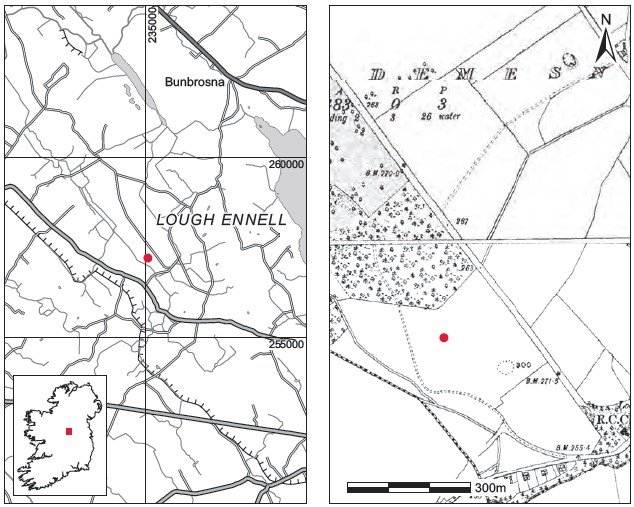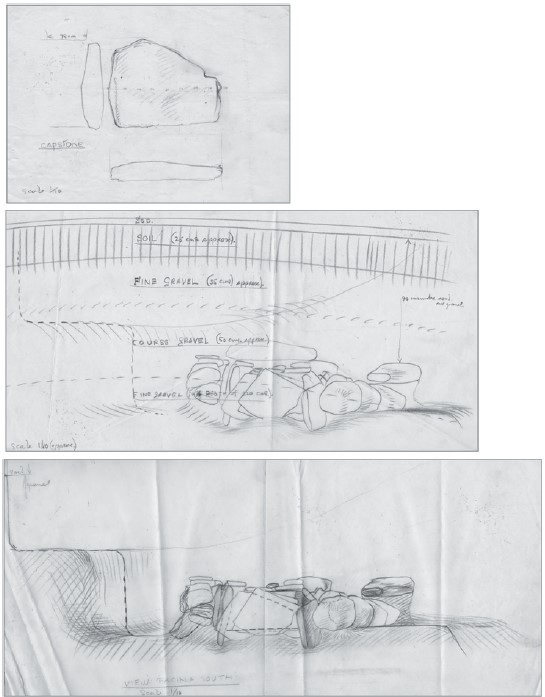1954:020 - SONNAGH DEMESNE, CO. WESTMEATH, Westmeath
County: Westmeath
Site name: SONNAGH DEMESNE, CO. WESTMEATH
Sites and Monuments Record No.: SMR WM018-013
Licence number: E1179
Author: BREANDÁN Ó RÍORDÁIN
Author/Organisation Address: —
Site type: Early Bronze Age graves
Period/Dating: —
ITM: E 635233m, N 757336m
Latitude, Longitude (decimal degrees): 53.564750, -7.468144
Introduction
In early August 1954 an inhumation in a slab-lined grave (grave 1) was discovered during quarrying operations at a sandpit near Mullingar, Co. Westmeath. A number of unprotected burials had apparently been discovered earlier but had been reburied elsewhere. Owing to the presence of stone lining, it was felt that this might be an important discovery, and the human remains were covered up by the workmen pending an investigation. During this time any bone discovered was thrown in on top of the burial. The NMI, however, was not informed of the find until 10 August. A two-day excavation of the site was carried out by Breandán Ó Ríordáin. The excavation uncovered two further burials, a short cist containing a cremation (grave 2) and a bowl, and an unprotected crouched inhumation (grave 3). Samples from all three burials have been dated and place the two inhumations (i.e. graves 1 and 3) in the early medieval period, while the cremation dates from the early Bronze Age (see Chapter 4 for the other burials). The human remains were initially examined by Dr David M. Davies and have been re-examined by Laureen Buckley.
Location (Fig. 3.205)
The site was in the townland of Sonnagh Demesne, just 7km north-west of Mullingar town, Co. Westmeath.349 The site was a sandpit on a gradual incline at an altitude of 70–80m above sea level. Lough Owel is 4km to the east and the highest point in the area is Frewin Hill, 171m above sea level, which is located approximately 3km north-east of Sonnagh Demesne.
Grave 2
This burial was contained in a short cist and was discovered by Ó Ríordáin during the excavation of grave 1 (Figs 3.206–8). It was situated immediately east of grave 1 at a depth of 0.96m below ground level. The cist was rectangular in plan, with its long axis aligned northwest/south-east (Pls 68–9). It measured 0.54m long by 0.45m wide by 0.3m high. Each wall of the cist was formed of a number of inclining edge-set slabs placed parallel to each other.

Fig. 3.205—Location map, Sonnagh Demesne, Co. Westmeath.

Fig. 3.206—Plan and section of grave 2, Sonnagh Demesne, Co. Westmeath.


Fig. 3.207—Sections of grave 2, Sonnagh Demesne, Co. Westmeath.

Fig. 3.208—Plan and sections of capstone; side elevations of grave 2, Sonnagh Demesne, Co. Westmeath.

Fig. 3.209—Ceramic vessel, Sonnagh Demesne, Co. Westmeath.
These slabs were further supported by a large number of packing stones placed outside the eastern, western and southern walls. The cist was sealed by a subrectangular capstone measuring 0.78m long by 0.63m wide by 0.15m thick. The floor of the cist was not paved but was formed of the natural sand into which the cist had been placed. The cist contained the cremated bones of an adult male (P1954:17) and a tripartite bowl. The cremation was found in the lower levels of the cist, beneath a thick layer of sand. The bowl, incomplete when discovered, was located at the northern side of the cist and further fragments were found in the centre of the cist. Ó Ríordáin speculated that it may have shattered as a result of the collapse of one of the cist walls.
Tripartite bowl, P1954:15 (Fig. 3.209)
The reconstructed vessel is somewhat bowl-shaped. It has a double moulding just above centre, between which are grooved lines. The overall decoration is horizontally placed and consists, with the exception of the plain grooved lines, of chevron-like lines and horizontal grooved lines embellished with cog-wheel and large comb-type ornament. The rim is bevelled internally and decorated with slanting rows of impressed cog ornament. The base is plain. The fabric is reddish on the outside with a black core. Part of the outside is also blackened. There is lime encrustation on the rim and upper body.
Dimensions: H 12cm; ext. D rim 15cm; D of base 4.5cm
Comment
A sample of the human remains yielded a radiocarbon date of 3580±70 BP, which calibrates to 2135–1746 BC at 95.4% probability.350 Brindley (2007, 248) places this bowl in stage 3 of the development of bowl tradition pottery, which is dated to 1980–1930/20 BC.
HUMAN REMAINS
LAUREEN BUCKLEY
Grave 2 (1954:17): cremation, adult male
This burial consisted of a cremation in a short cist. There were a total of 1,183 fragments of bone, weighing a total of 860g. The bone was white and efficiently cremated, with numerous horizontal fissures on the bone surface. The fragmentation of the bone is shown in Table 3.127, with the largest fragment being 84mm in length.
Table 3.127—Fragmentation of bone, grave 2, 1954:17.

It can be seen that over half the sample consists of very large fragments and that almost all the sample is made up of large fragments more than 15mm in length. Most of the smaller fragments probably came from post-excavation fragmentation of the bone. Despite small fragments not being collected, it can be assumed, since the sample is so large, that the bone was not deliberately crushed after collection from the funeral pyre.
Identifiable bone
A total of 476g (55% of the total bone) was identified (Table 3.128). This is a high percentage of identifiable bone and is due to the number of very large fragments. Table 3.129 summarises the main parts of the skeleton identified from this sample. It can be seen that the proportion of skull is exactly twice what would be expected from a normal cremation, but the amount of axial skeleton is much lower. The vertebrae and ribs tend to break into small fragments of bone that are not picked up, especially if there is a tendency to pick only larger fragments of bone. It can also be seen that the amount of upper limb is less than what is expected and that the amount of lower limb is almost exactly what would be expected from a normal cremation. It seems that the larger, more obvious bones of the skull and lower limbs were preferentially collected in this instance.
Table 3.128—Proportion of identified bone, grave 2, 1954:17.

Table 3.129—Summary of identified bone, grave 2, 1954:17.

Description of identifiable features of the bones
Skull
There were several fragments of frontal, parietal and occipital bone. The basal occipital bone was also present and there was a complete right zygomatic bone. The right mastoid and part of the squamous temporal bone was present but the mastoid process was incomplete. The right petrous part of the temporal bone, the right mandibular fossa and the zygomatic arch were also present. The right supraorbital ridge was present, as well as the right orbit. The supraorbital ridge was of the male type.
Mandible and maxilla
Fragments from the right and left side of the body of the mandible were present, as well as the left ramus and left condyle. One fragment of the right side of the maxilla was present. It was stained green in the nasal area.
Dentition
The following tooth sockets were present:

The roots of two incisors and two premolar teeth were also present.
Vertebrae
The dens articulation area of the first cervical vertebra and two bodies and a few articular surfaces from the lower cervical vertebrae were present. There were also two fragments of thoracic bodies and three fragmented neural arches. Two lumbar bodies and a few articular surfaces were also present.
Ribs
There were at least three left and three right ribs present and several other fragments of shaft.
Pelvis
There was a large fragment of the right ilium with part of the acetabulum present. There were several other fragments of ilia, including some from the iliac crest.
Scapulae
A fragment of left glenoid fossa and one fragment of the acromial spine were present, as well as a lateral border.
Humerus
The proximal ends of two bones and some fragments of shaft were present.
Radius
The proximal articular surfaces of two bones were present, as well as the proximal third of the shaft of a left radius and other shaft fragments.
Ulna
There was one fragment of proximal joint surface, a fragment of proximal shaft, two fragments from the distal third of the bone and one fragment of distal joint surface.
Carpals, metacarpals and phalanges
A left and right lunate, left and right scaphoid, right trapezoid and a complete pisiform were present from the carpal bones. Two first metacarpals, a second metacarpal and seven metacarpal shafts were present, as well as two fragments of metacarpal heads. There were eight proximal, two middle and two distal hand phalanges present.
Femur
Fragments of shaft and fragments of two distal articular surfaces from an adult bone were present.
Tibia
One large fragment from the distal half of the left tibia was present. There was also a distal end of a right tibia. The anterior tubercle of the left bone was present and there were several other fragments of shaft.
Fibula
There were fragments of shaft and the distal third of a right bone, as well as one proximal joint surface.
Patella
There was one almost complete right patella with a vastus notch.
Tarsals/metatarsals
Fragments from two tali, one navicular, one calcaneum and a fragment of left first cuneiform remained from the tarsal bones. There was a left first metatarsal shaft and fragments of three other shafts. One sesamoid bone was also present.
Minimum number of individuals
There appears to be one individual present as there is no repetition of skeletal elements. It seems to be the remains of one adult male.
Summary and conclusions
This sample represents the efficiently cremated remains of one adult male. All parts of the body were represented, but it seems that the skull and long bones of the leg were preferentially collected over the smaller, fragile bones of the axial skeleton. The bone was in relatively large fragments and does not appear to have been crushed as part of the cremation ritual.
349. Parish of Templeoran, barony of Moygoish. SMR WM018-013——. IGR 235290 257315.
350. -24192.
